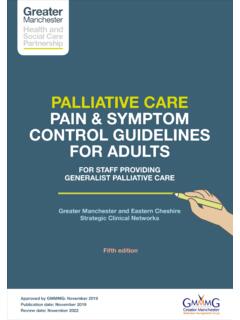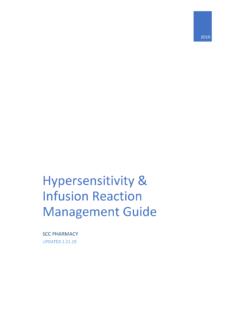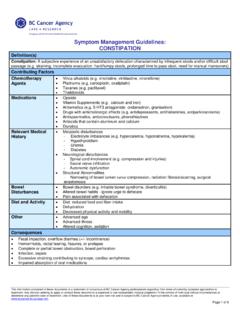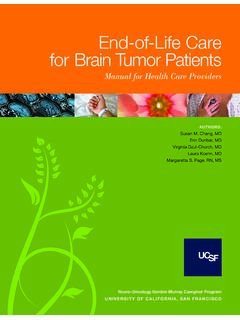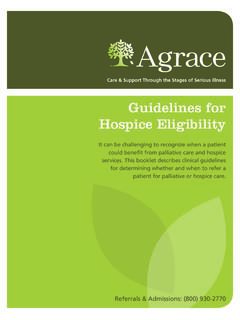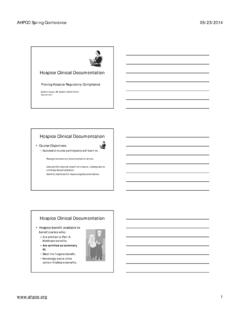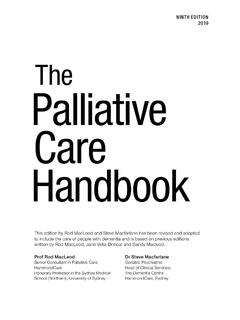Transcription of THE PALLIATIVE CARE HANDBOOK THE PALLIATIVE CARE …
1 THE PALLIATIVE care HANDBOOK A Good Practice Guide Ninth EDITION in association with all the Wessex Specialist PALLIATIVE care units THE PALLIATIVE care HANDBOOK A Good Practice Guide Wessex PALLIATIVE Physicians Ninth edition 2019 What Matters 3 Golden rules: Key Principles of symptom management 4 Pain 5 Assessment 5 Drug Treatment: Analgesic Ladder 6 Opioid Conversions: Table 10 Breakthrough Pain 12 Opioid Side Effects and Toxicity 13 Opioid Switching 14 Instructions to Patient and Carers 14 Opioids and Travel: Driving and Travel Abroad 15 Pain Associated with Cancer 16 Adjuvant Analgesia 18 Neuropathic Pain 19 Pains amenable to Interventional Procedures 20 Pain Associated with Neurological Disease 21 Pain Associated with Respiratory & Cardiac Disease 21 Pain Associated with Liver Disease 22 Pain Associated with Renal Disease 23 Respiratory 24 Breathlessness 24 Hoarse Voice 28 Cough 29 Gastrointestinal 30 Nausea and Vomiting 30 Intestinal Obstruction 34 Mouth Problems 36 Anorexia 38 Anorexia Cachexia (Fatigue)
2 Syndrome 39 Constipation 40 Diarrhoea 42 Fistulae 43 Ascites 44 Neurological 46 Raised Intracranial Pressure 46 Fits (Seizures) 47 Malignant Spinal Cord Compression 49 Hiccup 51 CONTENTS 1 Restlessness 52 Delirium 53 Insomnia 55 Drowsiness 56 Skin 57 Sweating/Hyperhidrosis 57 Itch 58 Malignant Ulcers/Fungating Wounds 59 Lymphoedema 60 Miscellaneous 62 Anaemia 62 Bleeding (Haemorrhage) 63 Venous Thromboembolism 65 Hypercalcaemia 67 Steroid Use 69 Diabetes Mellitus 70 End stage Long-Term Conditions 73 End stage organ failure 75-80 End of Life 81 Future and Advance care Planning 81 Treatment Escalation Plans and DNACPR Decisions 83 Last Few Days of Life 84 Anticipatory Prescribing 86 Syringe Drivers 87 Setting Up 87 Drugs Used 89 Psychological 91 Depression 91 Anxiety 92 Breaking Bad News 93 Denial 95 Collusion 96 Psycho-social and Spiritual 97 Spiritual care 98 Culture 100 Bereavement 101 Index and Appendices 103 Indexes.
3 Subject & Drug 103 Abbreviations 105 Useful Reading 106 Credits 106 2 Ask what matters. Listen to what matters. Do what matters. Finding out what matters most to each individual enables us to give appropriate care that is centred around their goals of care . Planning ahead The aim of future or advance care planning (ACP) is to establish what matters most to the patient in order to plan and give the care that suits them best. This might range from rehoming a beloved pet to concern for their family, wishes for organ donation or a fear of dying in pain. Research has shown that patients and their families welcome the chance to have these discussions.
4 They should not cause distress but give reassurance that compassionate care is being tailored to the individual. Giving patients some control in the last weeks, months or years of their life enables them to focus on living as well as possible to the very end. The timing of these discussions is important. It is often helpful to include those close to the patient and for the health care professional to have built up a relationship with the patient. Conversations can take place over several different occasions, updating information as time passes. Patients often change their minds; about where they would prefer their care to be, because, as end of life approaches, their needs change.
5 It can be helpful to give the patient: Planning for your Future care - A Guide. There are also some handheld documents available for the patient to record their wishes themselves or with support from family or carers. ( My Wishes booklet) Your PALLIATIVE care service will be able to advise on documents available locally. Some patients will want to make this a more formal process, creating an Advance Decision to Refuse Treatment (ADRT). This enables patients to refuse life prolonging treatment; it needs to be written, signed and witnessed and include the phrase even if my life were at risk for each treatment refused for it be legally valid and applicable.
6 Examples of treatments that may refused would be artificial feeding, assisted ventilation, and IV antibiotics requiring hospital admission. The conversation should be documented and shared (with consent) in an agreed place, so that all professionals involved in their care know what really matters and aim to provide the care that matters to each individual patient. WHAT MATTERS? 3 Return to contents page There are some key principles or Golden Rules which underpin symptom management . These include: Assess and diagnose the cause of symptoms, before planning symptom management Treat potentially reversible causes, where appropriate Always consider non-drug approaches as they can be as important as the use of drugs management plan is influenced by prognosis and patient choice and depends on the therapeutic goal Plan regular REVIEW and reassessment for all symptoms Set therapeutic goals for drugs prescribed use opioids as analgesics, not for sedation All drugs need a review date.
7 The goal is to use the minimum effective dose Adopt a team approach Ask for specialist advice in difficult situations*GOLDEN RULES Site and effectAssociated symptomsImpact on livingPatient understandingExacerbating & relieving factorsPhysicalcauseBehaviouralresponseT reatment relatedSpiritual distressEmotional reactionsSocial stressesReverse the reversibleNon-drug measuresDrugtherapiesASSESSDIAGNOSEMANAG E4* For specialist use or after specialist advice only Return to contents page All sections of this book focus on management of patients with advanced and progressive disease, including both malignant and non-malignant conditions.
8 The advice is not meant to guide the management of chronic pain, which, though also multi-dimensional, requires long term management plans focusing more on psychological interventions and less on opioid use. Pain is a complex symptom which is influenced by physical, psychological, social and spiritual factors (total pain). There are often components of pain which are not amenable to analgesia but which need to be assessed and treated alongside physical pain to achieve good symptom control. Be aware that the presence of non-physical aspects of pain may lower the physical pain threshold. Multiple pains are common. In cancer patients with pain: one third will have one pain, one third will have two pains and one third will have three or more pains.
9 Multiple pains are also common in non-malignant and co-morbid conditions. They may also occur as a result of age, debility and medical treatment. Pain Assessment Assessment and management of pain should follow relevant Golden Rules and the steps outlined for assessment of any symptom (p4). It is important to assess each pain separately to make a diagnosis and treat accordingly. Pain assessment tools Tools such as a numerical rating scale or a visual analogue scale may help the patient to describe the severity of the pain and the response to treatment. Tools are also available for assessment of pain in people with learning difficulties, dementia and other communication issues.
10 Pain management Once a pain has been assessed and diagnosed, aim to treat any reversible cause and use non-drug measures. Alongside these, or if the cause is irreversible, the WHO Analgesic Ladder (p6) remains the basis for prescribing in all types of persistent pain. NON-DRUG TREATMENTS Include: Relaxation techniques Distraction Heat pad/ ice pack Physiotherapy and Occupational Therapy assessment and treatment to maximise function Psychological assessment and support Creative therapies Transcutaneous electrical nerve stimulation (TENS) and acupuncture PAIN 5* For specialist use or after specialist advice onlyReturn to contents page DRUG TREATMENTS WHO Analgesic Ladder Introduced for the treatment of cancer pain The principles of the ladder are applicable to pain in those with progressive non-cancer conditions.
